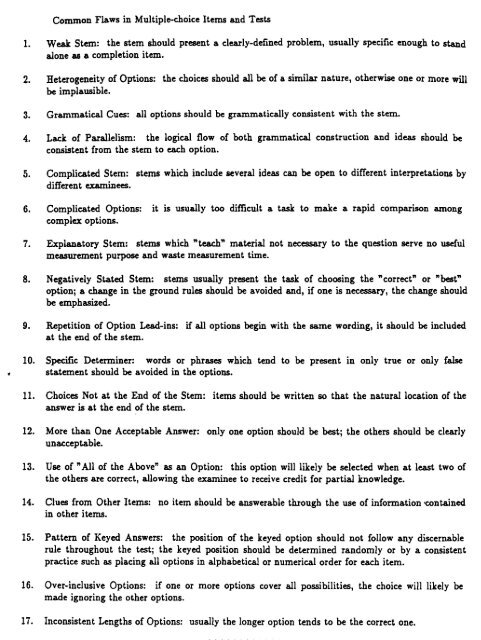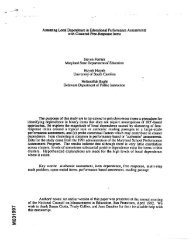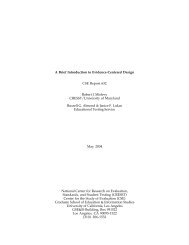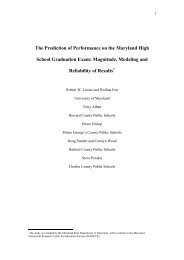Anonymous (XXXX) Rubric scoring and item writing.pdf
Anonymous (XXXX) Rubric scoring and item writing.pdf
Anonymous (XXXX) Rubric scoring and item writing.pdf
Create successful ePaper yourself
Turn your PDF publications into a flip-book with our unique Google optimized e-Paper software.
Common Flaws in Multiple-choice Items <strong>and</strong> Tests<br />
1. Weak Stem: the stem should present a clearly-defined problem, usually specific enough to st<strong>and</strong><br />
alone as a completion <strong>item</strong>.<br />
2. Heterogeneity of Options: the choices should all be of a similar nature, otherwise one or more will<br />
be implausible.<br />
3. Grammatical Cues: all options should be grammatically consistent with the stem.<br />
4. Lack of Parallelism: the logical flow of both grammatical construction <strong>and</strong> ideas should be<br />
consistent from the stem to each option.<br />
5. Complicated Stem: stems which include several ideas can be open to different interpretations by<br />
different examinees.<br />
6. Complicated Options: it is usually too difficult a task to make a rapid comparison among<br />
complex options.<br />
7. Explanatory Stem: stems which "teach" material not necessary to the question serve no useful<br />
measurement purpose <strong>and</strong> waste measurement time.<br />
8. Negatively Stated Stem: stems usually present the task of choosing the "correct" or "best"<br />
option; a change in the ground rules should be avoided <strong>and</strong>, if one is necessary, the change should<br />
be emphasized.<br />
9. Repetition of Option Lead-ins: if all options begin with the same wording, it should be included<br />
at the end of the stem.<br />
10. Specific Determiner: words or phrases which tend to be present in only true or only false<br />
statement should be avoided in the options.<br />
11. Choices Not at the End of the Stem: <strong>item</strong>s should be written so that the natural location of the<br />
answer is at the end of the stem.<br />
12. More than One Acceptable Answer: only one option should be best; the others should be clearly<br />
unacceptable.<br />
13. Use of "All of the Above" as an Option: this option will likely be selected when at least two of<br />
the others are correct, allowing the examinee to receive credit for partial knowledge.<br />
14. Clues from Other Items: no <strong>item</strong> should be answerable through the use of information tcontained<br />
in other <strong>item</strong>s.<br />
15. Pattern of Keyed Answers: the position of the keyed option should not follow any discernable<br />
rule throughout the test; the keyed position should be determined r<strong>and</strong>omly or by a consistent<br />
practice such as placing all options in alphabetical or numerical order for each <strong>item</strong>.<br />
16. Over-inclusive Options: if one or more options cover all possibilities, the choice will likely be<br />
made ignoring the other options.<br />
17. Inconsistent Lengths of Options: usually the longer option tends to be the correct one.






